How To Choose Some Categorical Data Seaborn
A Complete Guide to Plotting Categorical Variables with Seaborn
See how Seaborn can make your plots looks nicer, convey more than info, and require few lines of code
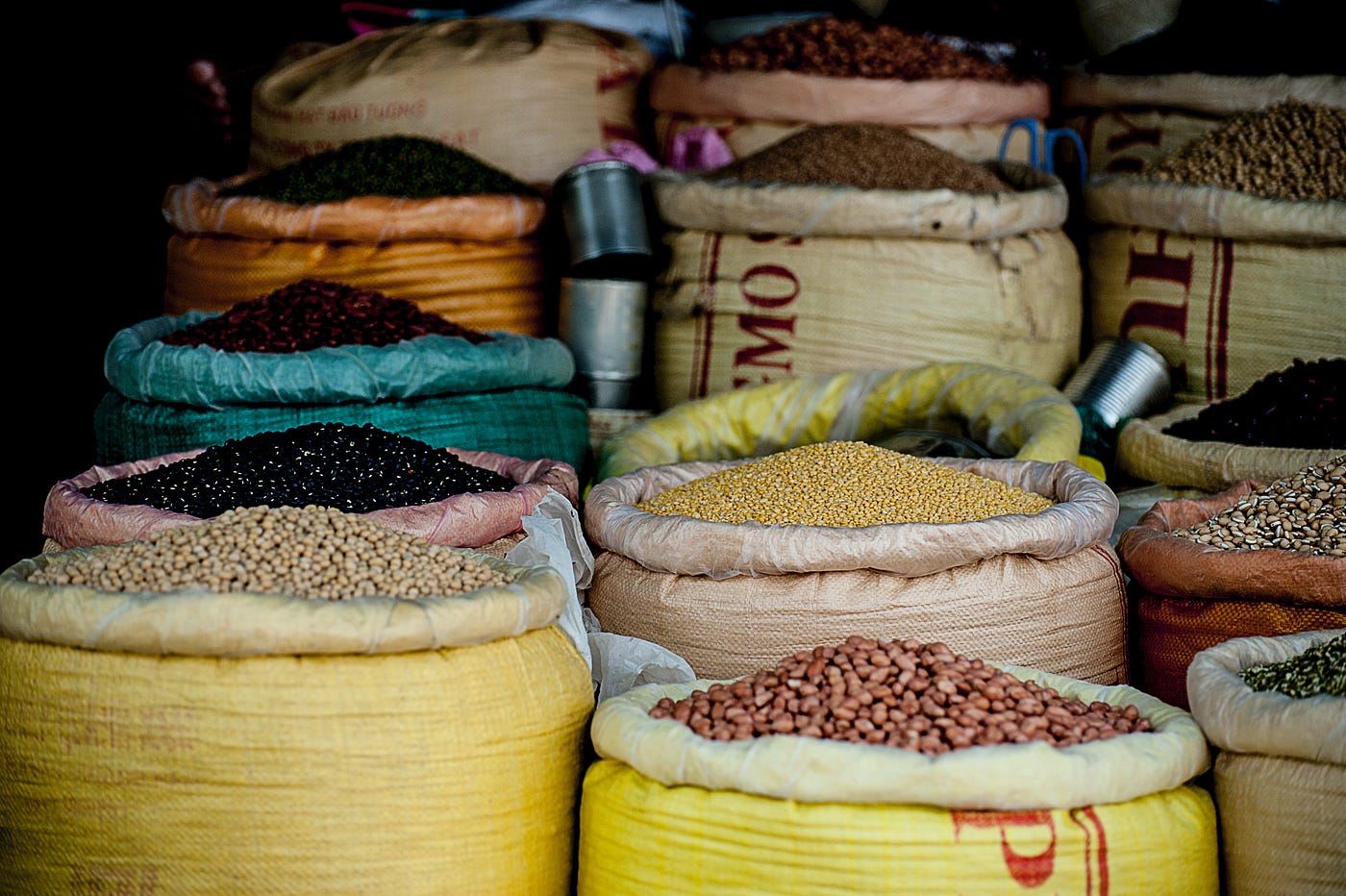
Table of Contents
· The Information
· Chiselled Distribution Plots
∘ Box Plots
∘ Violin Plots
∘ Boxen Plot
· Categorical Guess Plots
∘ Bar Plot
∘ Point Plot
∘ Count Plot
· Chiselled Scatter Plots
∘ Strip Plot
∘ Swarm Plot
· Combining Plots
· Faceting Data with Catplot
· Documentation and Links
The Data
In this post we volition use one of Seaborn's conveniently available datasets about the Titanic, which I'm certain many readers have seen before. Seaborn has quite a few datasets ready to be loaded into Python to practice with; they are smashing for practicing information processing, exploration, and basic motorcar learning techniques.
titanic = sns.load_dataset('titanic') titanic.head()

titanic.info() titanic['species'].unique()
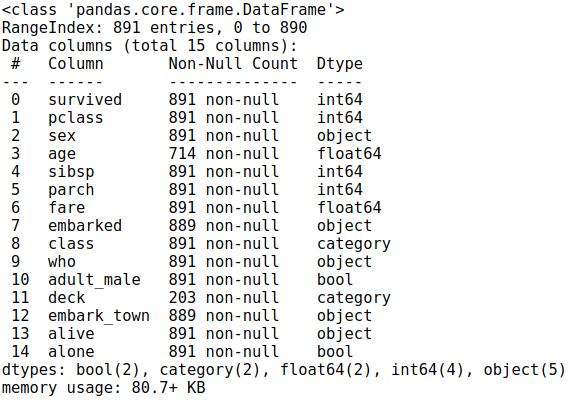
This data fix is great considering it has a decent number of entries — almost 900 — while too having an interesting story to dig into. There are lots of questions to ask and relationships between variables to explore making it a groovy example data set. Most critical for this article is that there is as well a good mix of numerical and chiselled variables to explore.
Categorical Distribution Plots
We have two different kinds of chiselled distribution plots, box plots and violin plots. These kinds of plots let us to choose a numerical variable, like historic period, and plot the distribution of age for each category in a selected chiselled variable.
Box Plots
Many of us have probably made quite a few box plots over the years. They are an easy and effective style to visualize groups of numerical information through their quartiles. Seaborn makes creating bonny box plots simple and allows us to hands compare an extra dimension with the hue statement that appears in many Seaborn functions.
Basic Boxplot
Lets take a look at distribution of age past rider class.
plt.figure(figsize=(eight,5)) sns.boxplot(ten='class',y='historic period',data=titanic, palette='rainbow') plt.title("Age by Rider Class, Titanic")
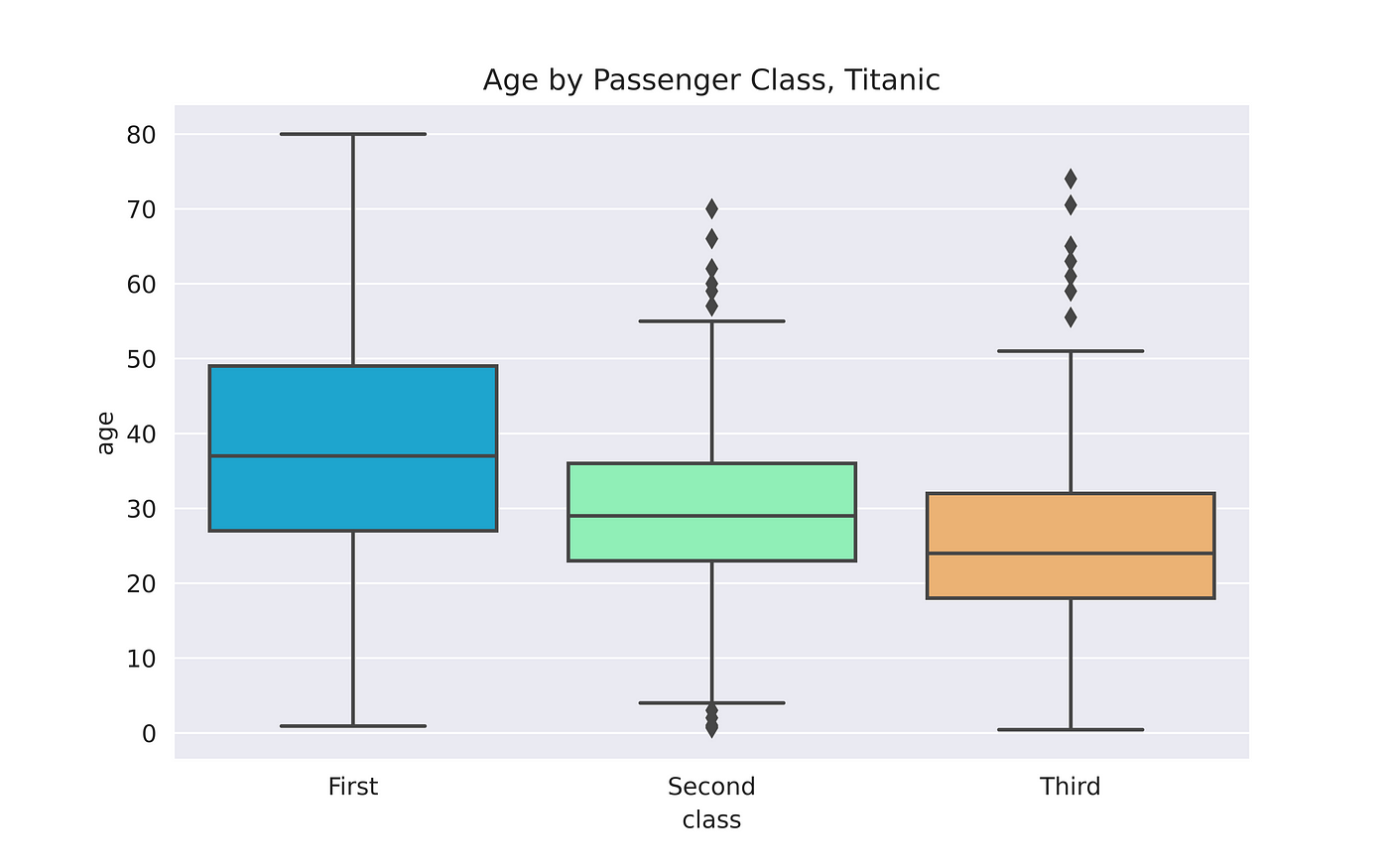
We can see that age tends to decrease as yous get down in passenger form. That makes sense, young people tend to travel on a budget. Notice how little code this required to create a pretty aesthetically pleasing plot? Seaborn'southward bones plots are very polished.
Besides pay attention to how we can wrap Matplotlib formatting syntax around our Seaborn plots. This only works when nosotros are using Axis-level functions, which you tin read about in another ane of my posts virtually effigy-level and axis-level functions in Seaborn.
Calculation Hue
Similar many other plots bachelor in Seaborn, box plots tin can take an added hue argument to add some other variable for comparison.

Adding the hue shows united states that regardless of grade the historic period of passengers that survived was mostly lower than those who passed away.
Having the hue for additional comparison allows this box plot to be quite data dense. The more complex the plot gets the longer it will take for viewers to encompass it, simply it is nice to accept the choice when interesting insights are more easily shown with an added dimension.
Violin Plots
Violin plots are not very frequently used only I have found them to be useful on occasion, and they are an interesting change from more popular options. They plot a vertical kernel density plot for each category and a small-scale box plot to summarize of import statistics.
plt.figure(figsize=(10,six)) sns.violinplot(x='class',y="age",data=titanic, hue='sexual activity', palette='rainbow') plt.title("Violin Plot of Historic period past Course, Separated by Sex activity")
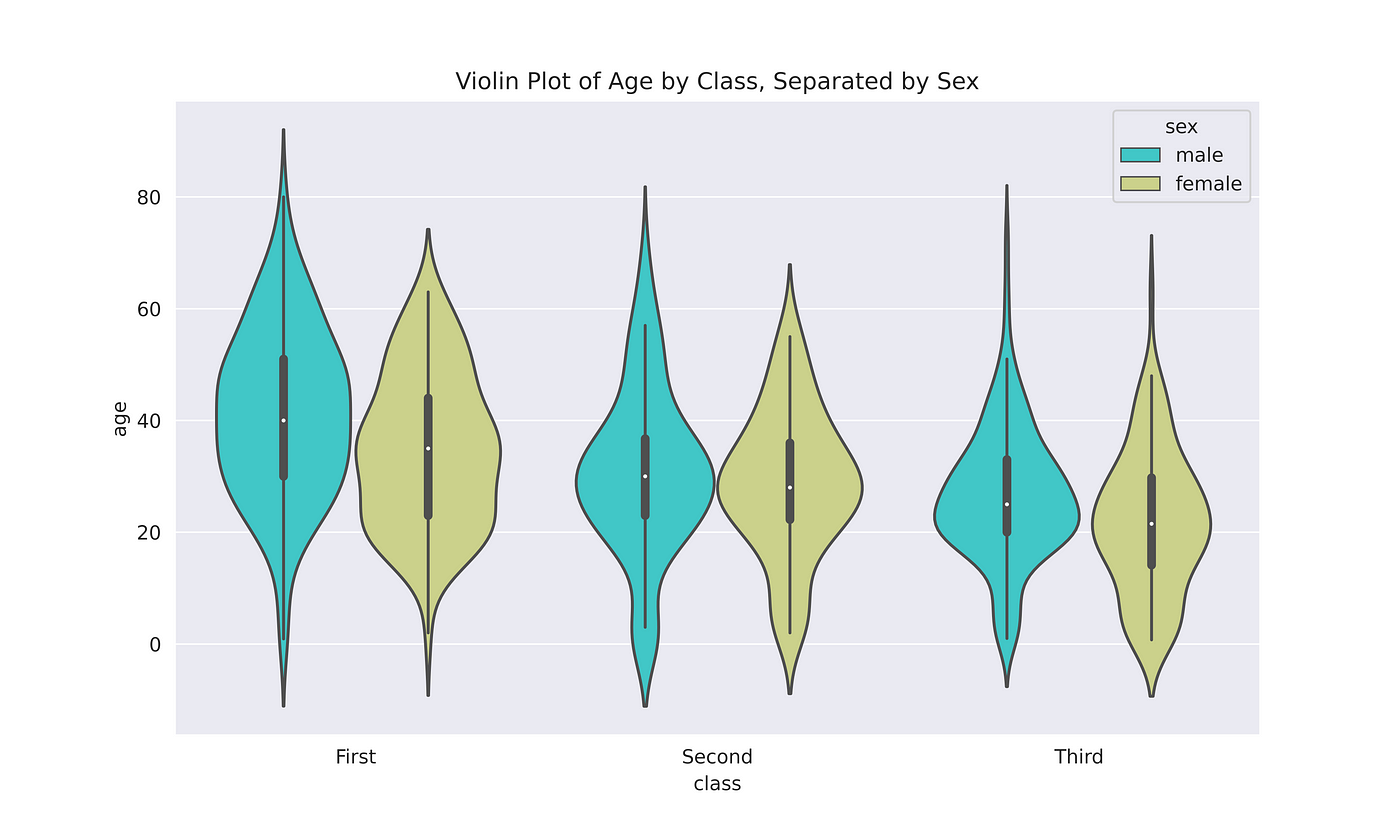
While I like this plot, I think information technology is easier to compare the genders with slightly different formatting:
plt.figure(figsize=(x,six)) sns.violinplot(x='class',y="age",data=titanic, hue='sex', split='True', palette='rainbow') plt.title("Violin Plot of Age past Course, Separated past Sex activity")

When we split the violin on the hue it is a lot easier to see the differences in each KDE. However, the IQR stats aren't split past the sexual activity anymore; instead they apply to the entire course. So at that place are trade-offs to styling your plot in certain ways.
Boxen Plot
The boxen plot, otherwise known as a Letter-value plot, is a box plot meant for large data sets (n > 10,000). Information technology is similar to a traditional box plot, however it essentially just plots more quantiles. With more quantiles, nosotros tin can see more info nigh the distribution shape beyond the central 50% of the data; this extra particular is specially present in the tails, where box plots tend to requite limited information.
plt.figure(figsize=(8,5)) sns.boxenplot(x='class', y='age', data=titanic, palette='rainbow') plt.title("Distribution of Age past Passenger Class")
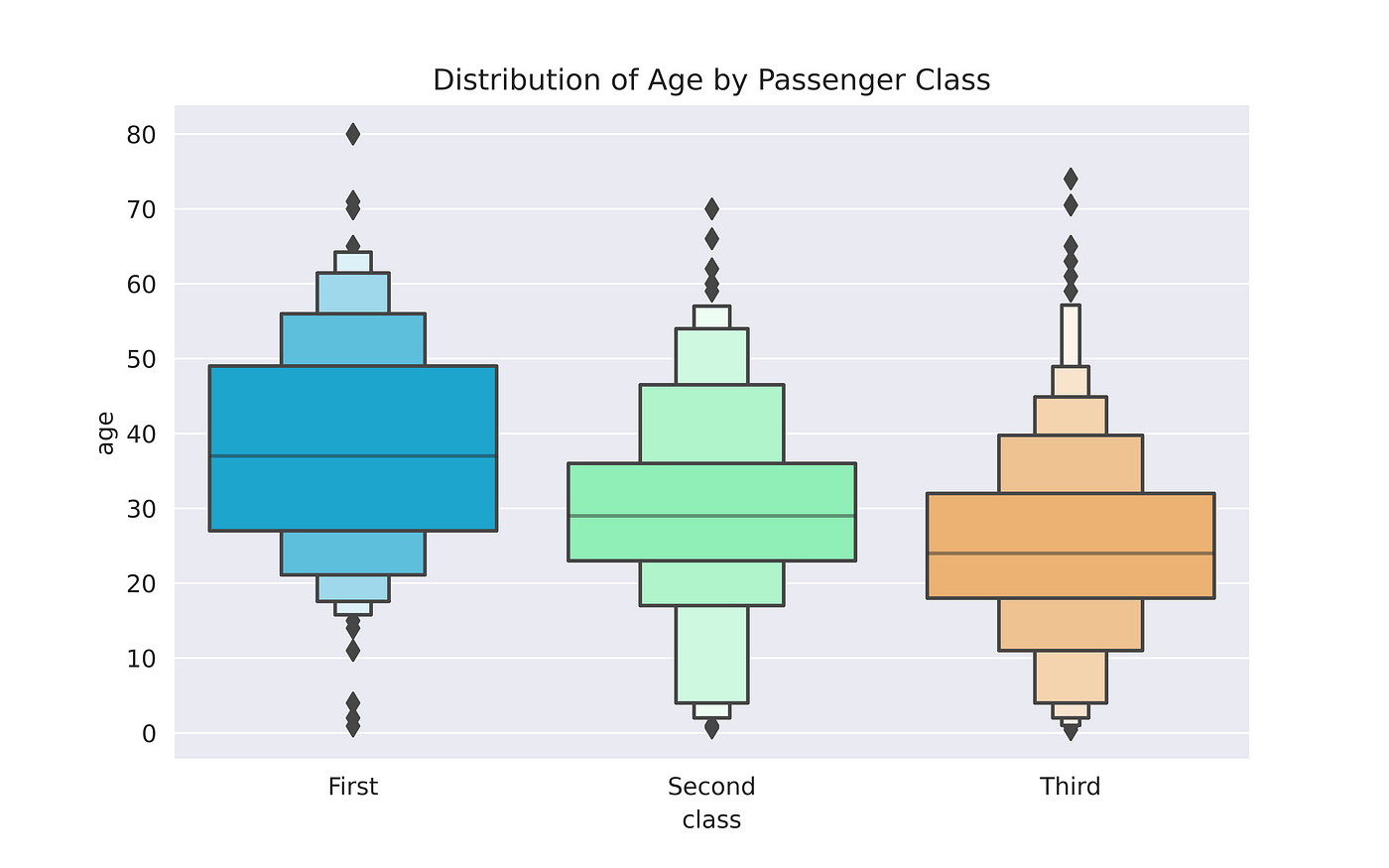
Just in case at that place still isn't plenty going on here for you, we can also add a hue to a boxen plot!
plt.effigy(figsize=(8,five)) sns.boxenplot(x='class', y='age', information=titanic, palette='rainbow', hue='survived') plt.title("Distribution of Age by Passenger Grade, Separated past Survival")

We tin can encounter that the boxen plot gives u.s.a. much more information beyond the central 50% of the data. Nevertheless, keep in mind that boxen plots are meant for larger data sets with entries between 10,000 and 100,000. This data set of nether 1,000 entries is definitely not ideal. Here is a link to the paper where boxen plots were created that explains them very well.
Categorical Estimate Plots
Bar Plot
Bar plots are classic. You go an gauge of central tendency for a numerical variable for each class on the 10 axis. Say we were interested in knowing the boilerplate fare price of passengers that embarked from different towns:
plt.figure(figsize=(8,5)) sns.barplot(x='embark_town',y='fare',data=titanic, palette='rainbow') plt.title("Fare of Passenger past Embarked Town")
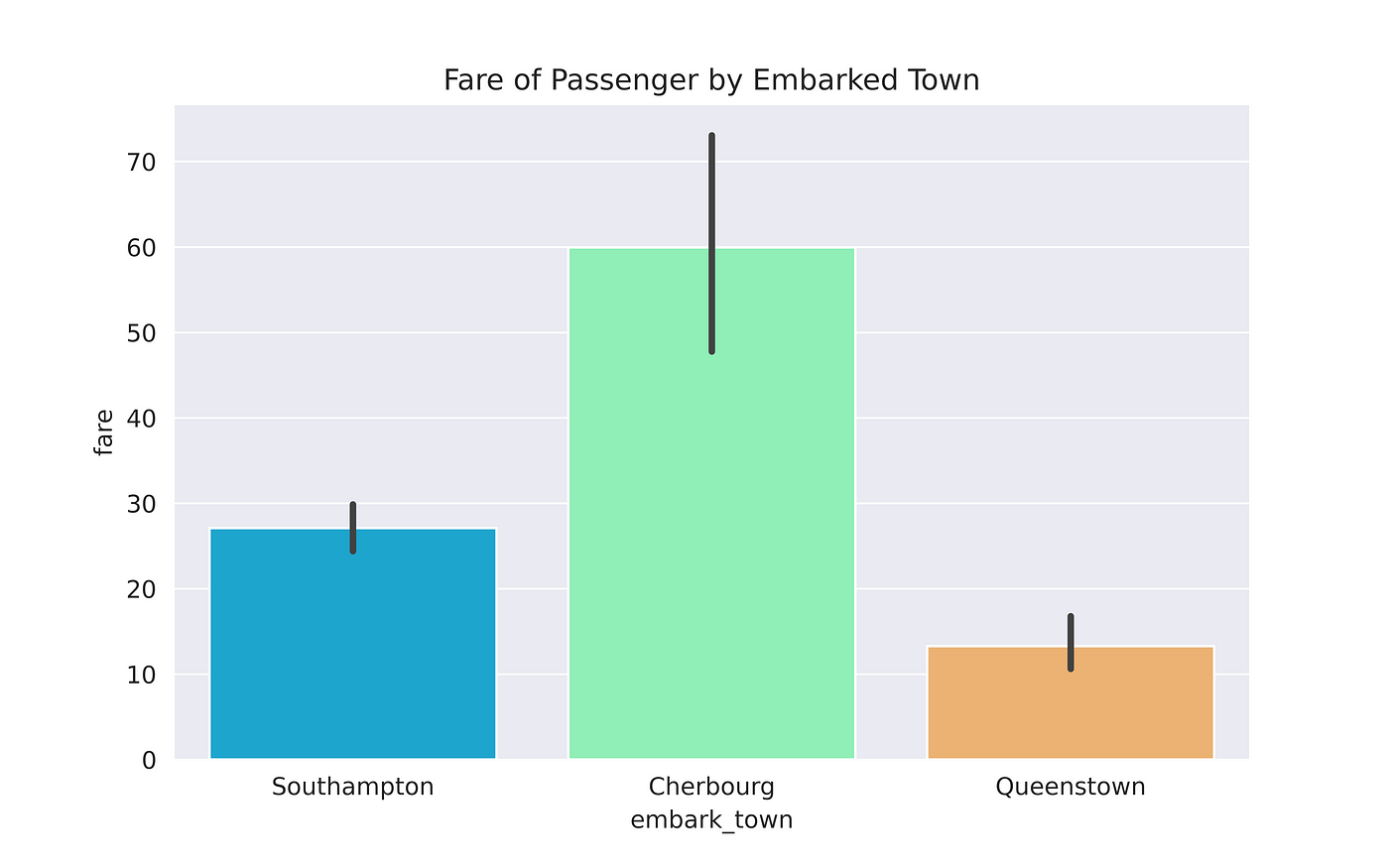
Seaborn will take the hateful as default, but you tin utilise other measures of central trend equally well. In that location is a noticeable difference betwixt Cherbourg and the other 2, let'southward divide the bars by class to see who was boarding in each town.
plt.effigy(figsize=(8,v)) sns.barplot(x='embark_town',y='fare',data=titanic, palette='rainbow', hue='class') plt.title("Fare of Passenger by Embarked Town, Divided by Grade")
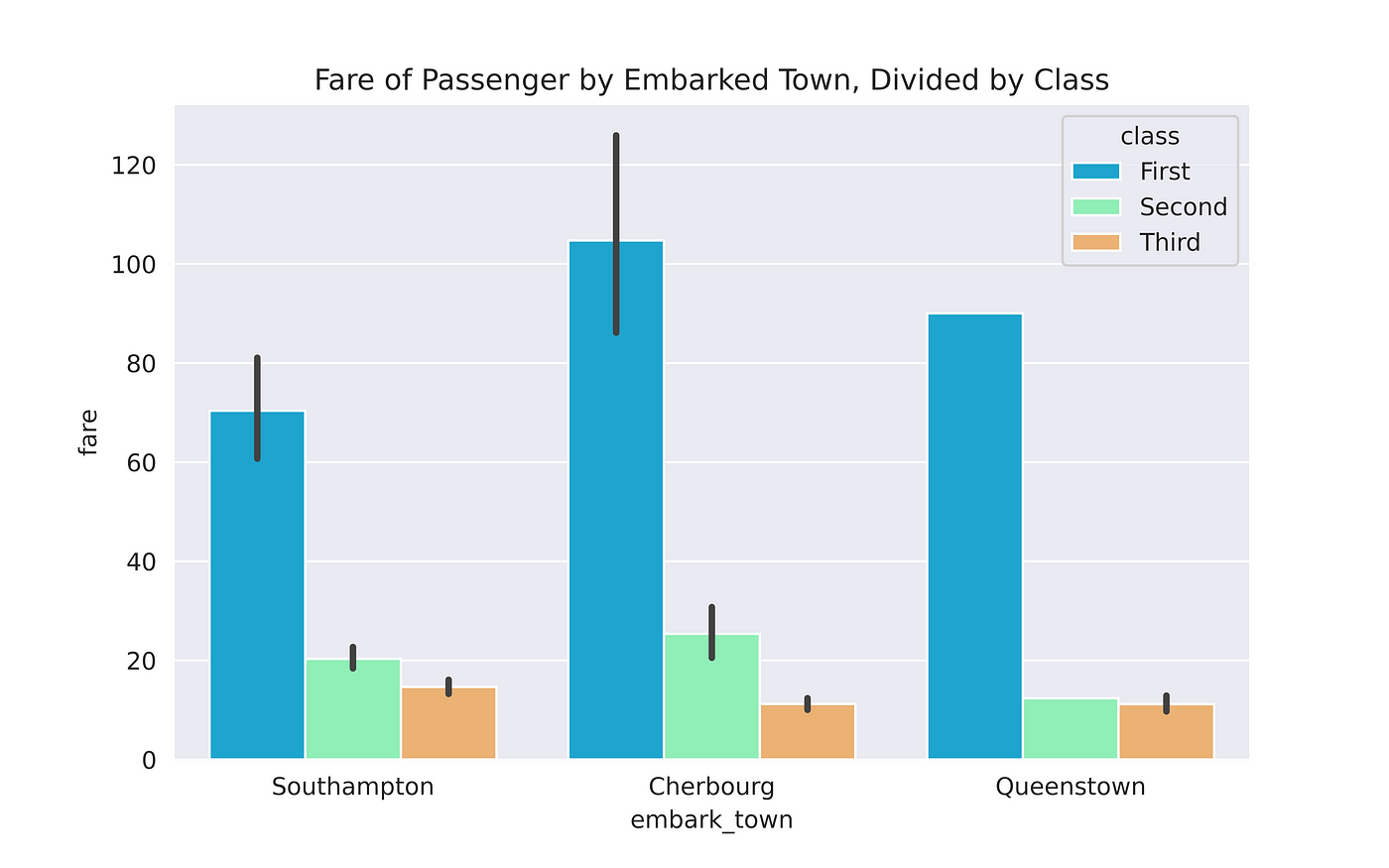
Now nosotros can see that the average fare toll in Cherbourg was so high due to some very expensive offset form tickets. The big fault bar on the fare toll in first class from Cherbourg is besides interesting; that could mean there is a lot of separation between some very high cost outlier tickets and the residual. We'll explore this farther in the combined plots section below!
Betoken Plot
Indicate plots convey the same information every bit a bar plot with a different style. They can be adept for overlaying with unlike plots since they accept a smaller footprint in the space.
plt.figure(figsize=(8,5)) sns.pointplot(x='embark_town',y='fare',information=titanic) plt.title("Average Fare Price past Embarked Boondocks")

plt.effigy(figsize=(8,five)) sns.pointplot(10='embark_town',y='fare',data=titanic, hue='class') plt.championship("Average Fare Price by Embarked Town, Separated past Sex")
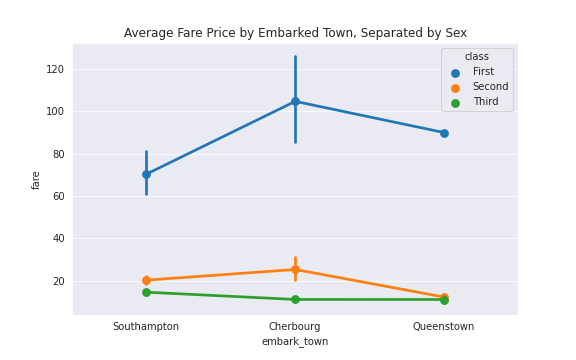
Count Plot
Count Plots are essentially histograms beyond a categorical variable. They take all the same arguments as bar plots in Seaborn, which helps proceed things simple.
plt.figure(figsize=(eight,5)) sns.countplot(10='embark_town',data=titanic, palette='rainbow') plt.title("Count of Passengers that Embarked in Each City")
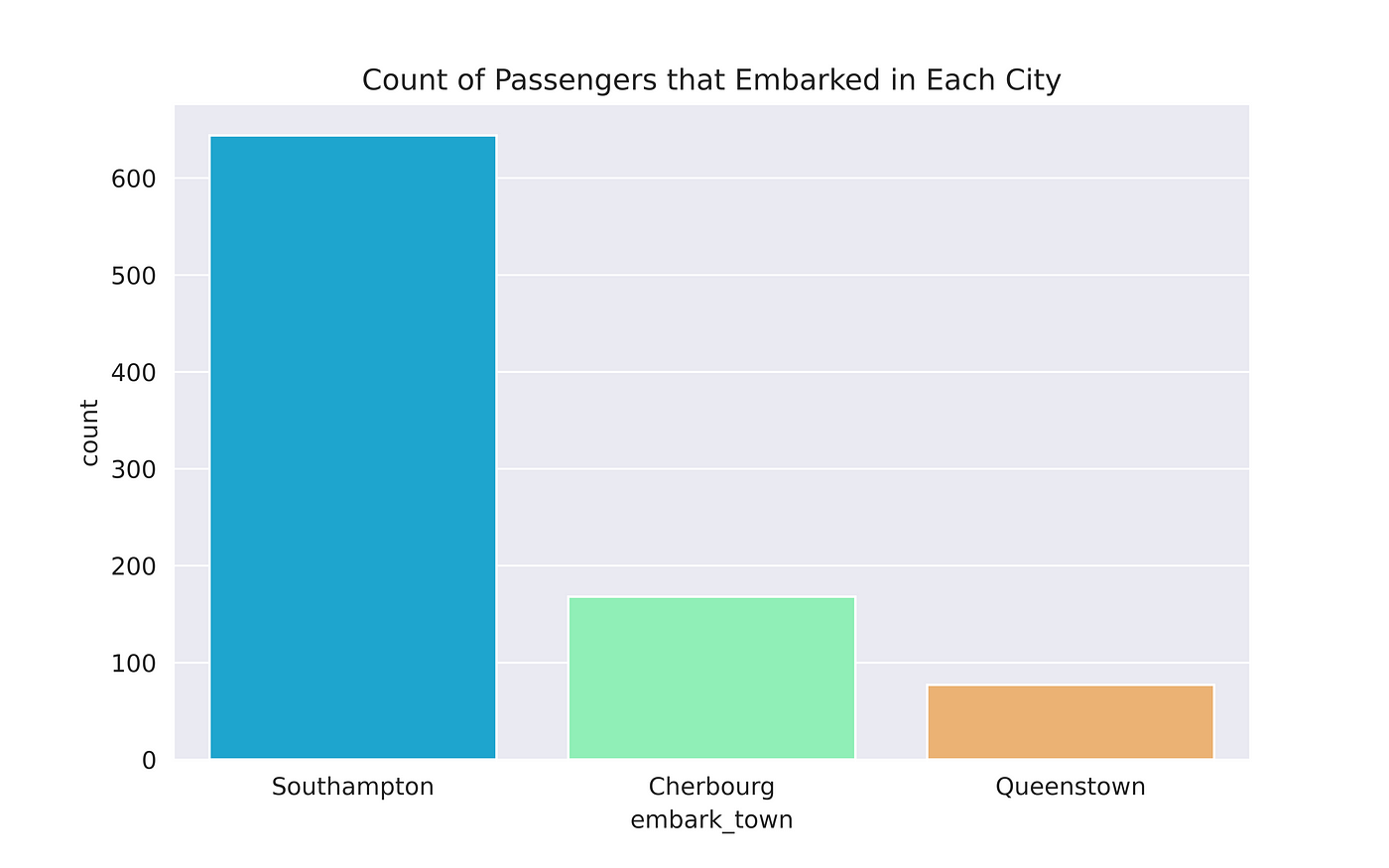
plt.figure(figsize=(eight,5)) sns.countplot(x='embark_town',data=titanic, palette='rainbow',hue='sex') plt.title("Count of Passengers that Embarked in Each City, Separated by Sex")
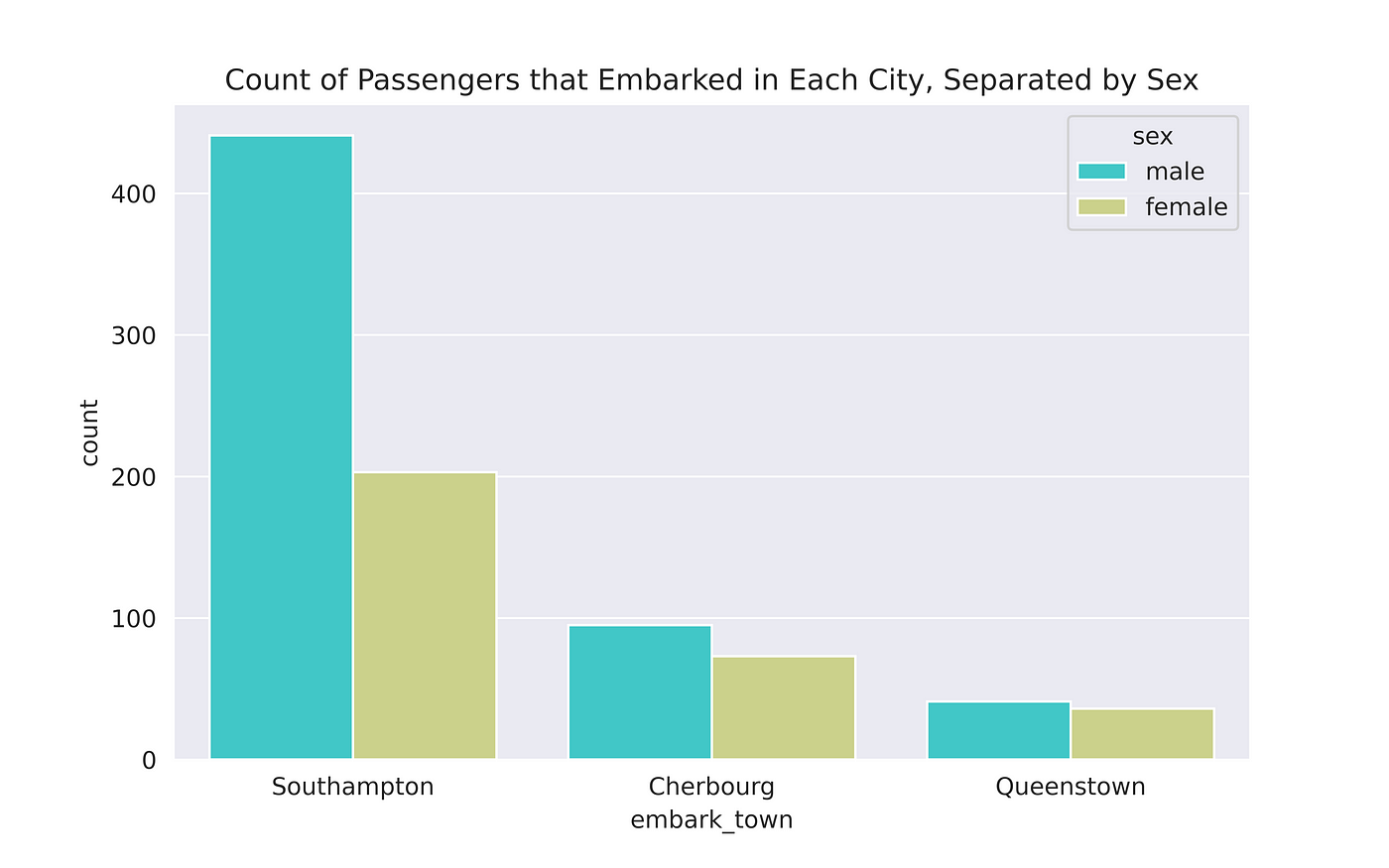
Categorical Scatter Plots
Both strip plots and swarm plots are substantially scatter plots where 1 variable is chiselled. I like to apply them as additions to other kinds of plots, which we'll discuss below as they are useful for chop-chop visualizing the number of data points in a group.
Strip Plot
plt.figure(figsize=(12,eight)) sns.stripplot(x='class', y='age', data=titanic, jitter=True, hue='alive', contrivance=Truthful, palette='viridis')
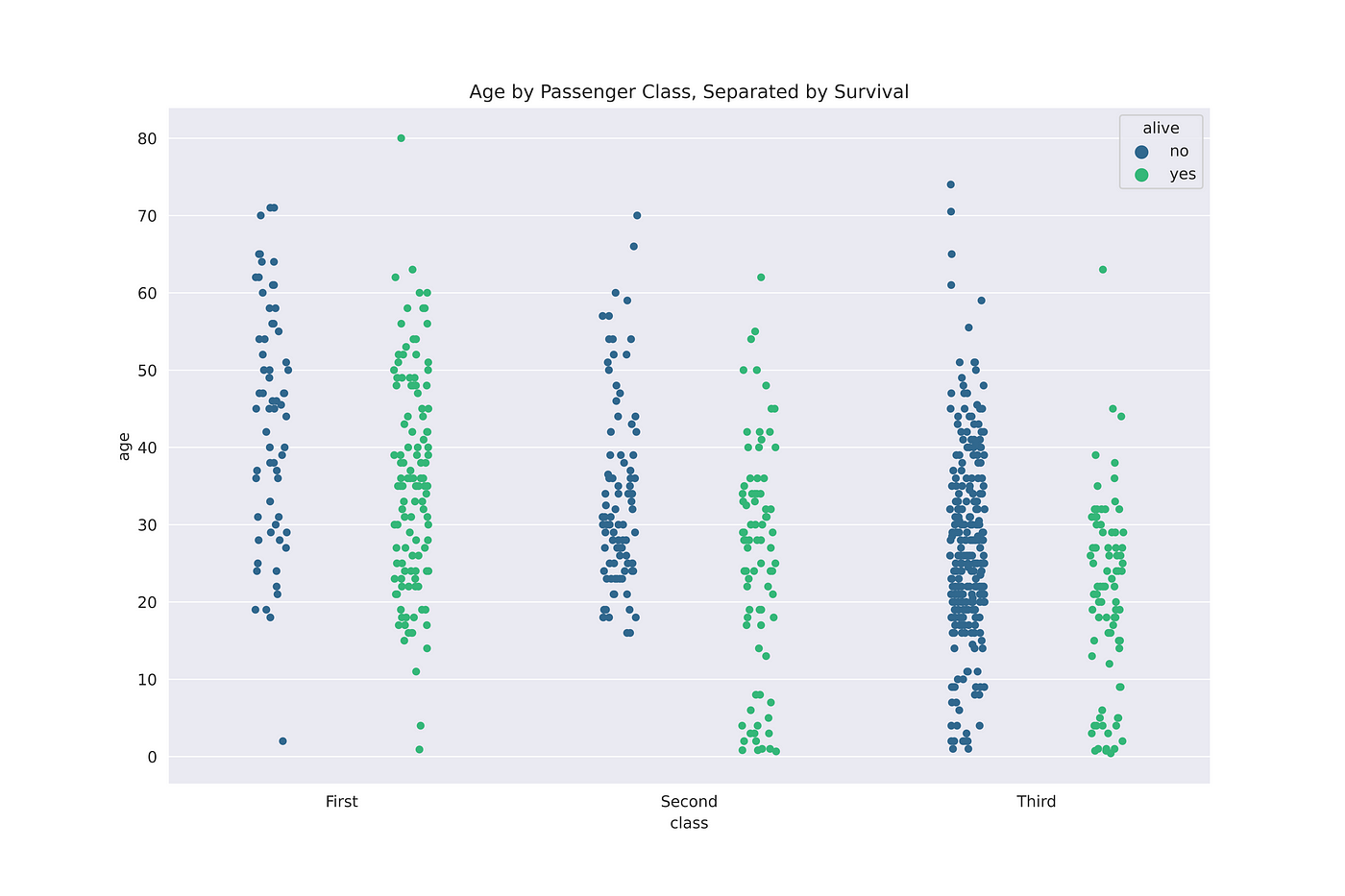
I don't love the way strip plots look when you take a lot of data points. But swarm plots might make this a little more useful. Strip plots can look great with less information points and they can convey really interesting attributes of your data since they don't hide details behind aggregation.
Swarm Plot
Swarm plots are fantastic because they offering an piece of cake way to show the private data points in a distribution. Instead of a big blob like the strip plot, the swarm plot only adjusts the points along the x-axis. Although they too don't scale well with tons of values, they offer more organized insight.
plt.figure(figsize=(10,7)) sns.swarmplot(x='class', y='historic period', information=titanic, hue='live', contrivance=True, palette='viridis') plt.championship("Age by Rider Class, Separated by Survival")
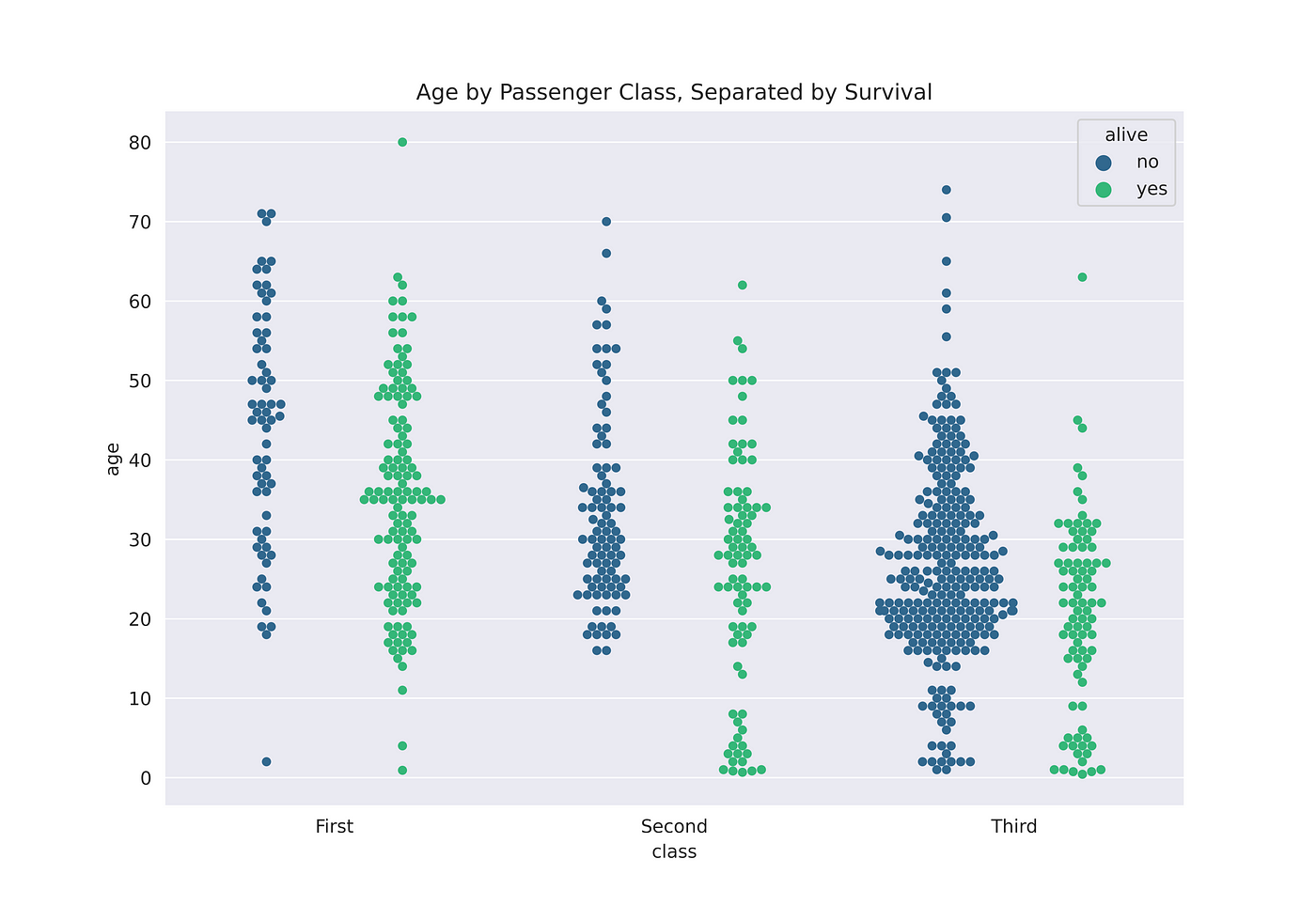
Here we tin more than easily see where the dense age groups are rather than the difficult to interpret strip plot above.
Combining Plots
One of my favorite uses for a swarm plot is to enhance another kind of plot since they convey relative book very well. Every bit nosotros volition see in the violin plot below even though at 1 betoken the KDE values may look similarly "big", the book of data points in each of the classes may exist quite dissimilar. We tin add a swarm plot on meridian of our violin plot to evidence the private data points that help to give us a more complete picture.
plt.figure(figsize=(12,8)) sns.violinplot(x='class',y="age", data=titanic, hue='survived', split='True', palette='rainbow') sns.swarmplot(ten='class',y="age", data=titanic, hue='survived', dodge='True', color='grey', alpha=.8, s=4) plt.title("Historic period by Passenger Class, Separated by Survival")
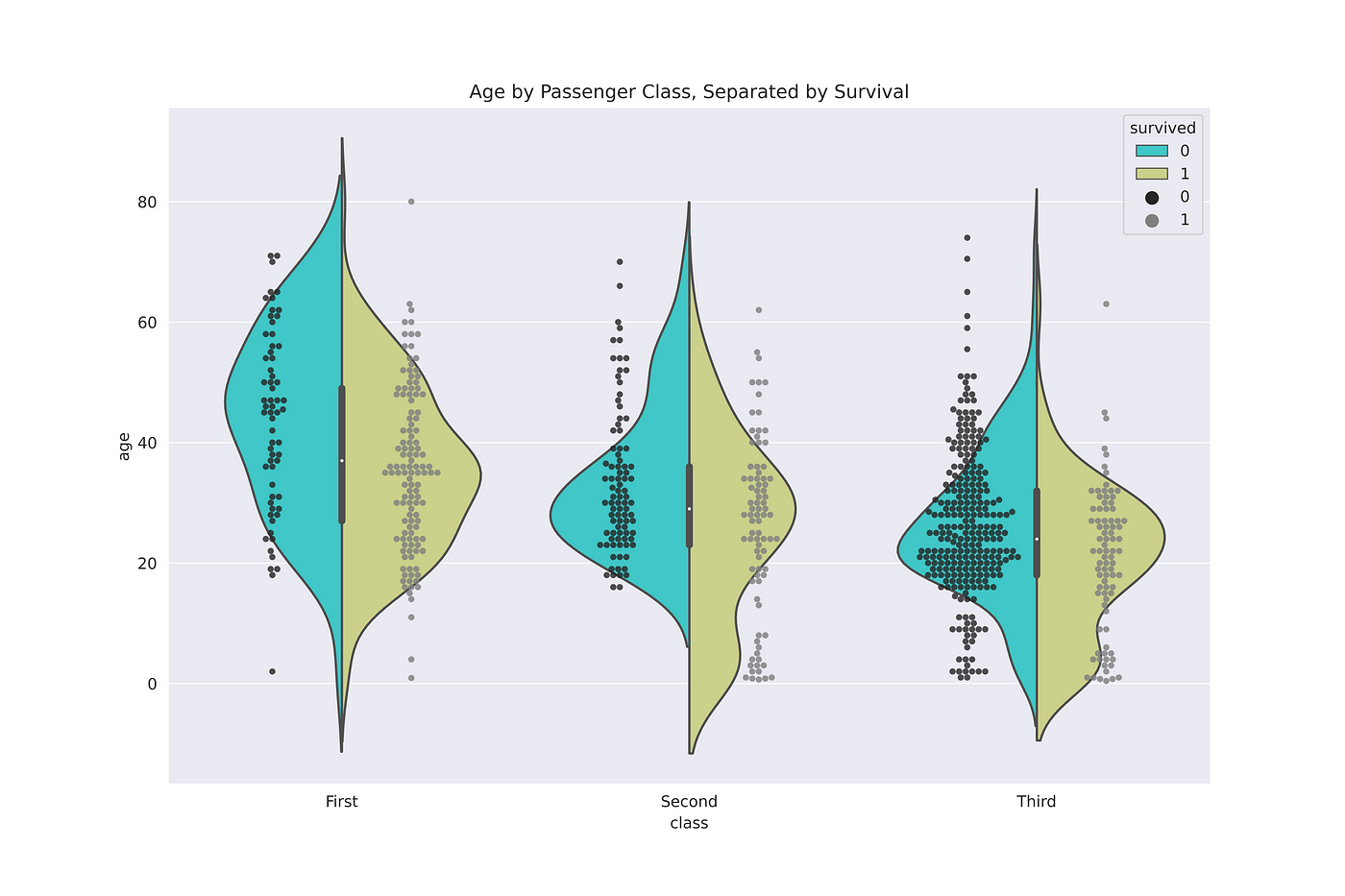
By calculation the swarm plot nosotros can see where the bodily majority of data points are contained. I have seen Violin plots misinterpreted many times where a viewer may assume a relatively like number of ~25 year one-time third course passengers lived and survived in tertiary grade, and the swarm plot does a groovy job immigration that up.
plt.figure(figsize=(12,viii)) sns.boxplot(ten='class',y='age',hue='survived',information=titanic, palette='rainbow') sns.swarmplot(10='class',y='historic period',hue='survived', dodge=Truthful,data=titanic, blastoff=.8,colour='gray',s=4) plt.title("Age by Rider Class, Separated past Survival")
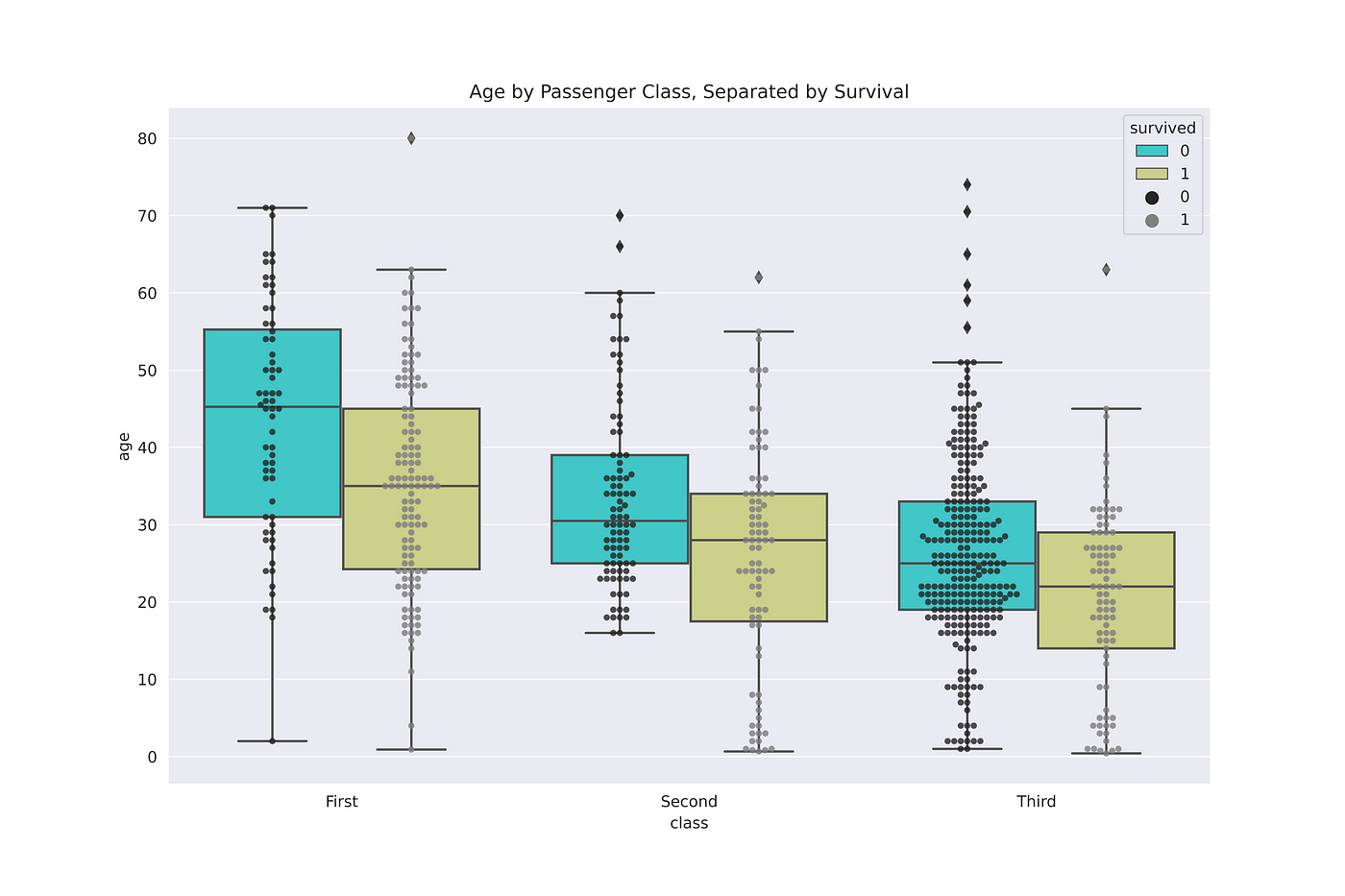
The story is very like with box plots every bit with violin plots. Summary statistics of each grouping are very useful, however adding the swarm plot helps to show a more consummate story.
Remember when were looking at the average ticket prices by the boondocks embarked from and separated past passenger form before?

We saw that the price of Cherbourg tickets was high, which turned out was due to the mean cost of first class tickets being so loftier in Cherbourg. We as well had this big error bar on the hateful toll of beginning grade tickets in Cherbourg. Using a strip plot, we tin can try to go a meliorate understanding of what's happening there.
plt.figure(figsize=(12,7)) sns.barplot(ten='embark_town',y='fare',data=titanic, palette='rainbow', hue='class') sns.stripplot(x='embark_town',y="fare",data=titanic, hue='class', dodge='True', color='grey', blastoff=.8, south=2) plt.title("Fare of Passenger by Embarked Town, Divided by Course")
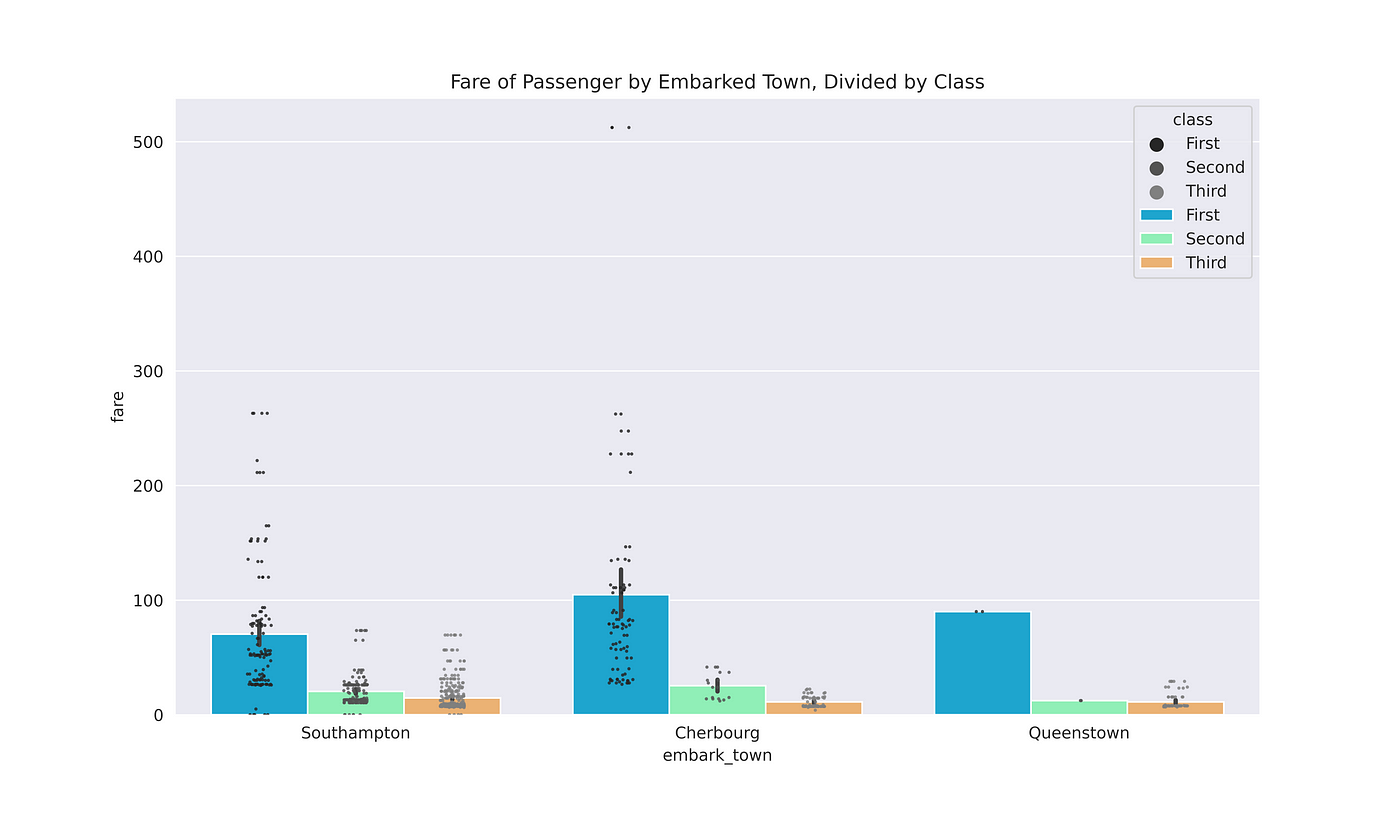
Now we can meet that there were two very expensive tickets sold in Cherbourg that skewed the hateful, which is why our first class bar plot had a large error bar. While two people paid close to double the side by side most expensive first class tickets, there were likewise people in first class that paid a lower fare than some of those who boarded in second grade! We get all kinds of new insights when nosotros combine plots.
Faceting Information with Catplot
Catplot() is the figure-level function that can create all of the above plots we have discussed. Figure-level functions plot a Seaborn object and interface with the Matplotlib API instead of creating a Matplotlib object like Seaborn's axis-level functions.
While working with figure-level functions is more often than not more complex and has less clear documentation, there are some strengths that brand them worth using in certain cases. They are particularly good at faceting data into subplots as we can encounter beneath.
g = sns.catplot(x='class',y='survived', col = 'who', data=titanic,
kind='bar', aspect=.half dozen, palette='Set2') (chiliad.set_axis_labels("Class", "Survival Rate")
.set_titles("{col_name}")
.set(ylim=(0,1))) plt.tight_layout()
plt.savefig('seaborn_catplot.png', dpi=one thousand)

Faceting data allows us to see data at different granularities. Faceting is really a fancy word for separating data into classes along a specific dimension(south). So hither we are separating the information forth the "who" variable, which allows us to plot each type of person separately.
Being able to say col='<column_name>' to automatically facet is a powerful choice that nigh figure-level functions have access to. Accomplishing the same thing in Matplotlib requires significantly more time subsetting data and creating multiple subplots manually. I discuss the power of figure-level plotting more than in this article.
Don't forget that nosotros could still add a hue statement to add even more information to this plot! Faceting data with Seaborn's effigy-level functionality can be an first-class manner to make more complex plots.
You will notice that Seaborn figures crave different functions for formatting, however saving the plot can still be done via plt.savefig() since the last Seaborn effigy interfaces with the Matplotlib API. I won't get into particular on figure-level plotting since at that place is a lot to discuss, but do read my other article about the topic if yous are curious.
Wrapping Up
We've gone through a lot of different plots in this post. I hope that you accept seen how piece of cake Seaborn can make an aesthetically pleasing plot that conveys a lot of useful information to the viewer. Once I got used to using information technology, Seaborn has saved me a massive amount of fourth dimension writing fewer lines of code to produce pleasing visualizations.
Documentation and Links
Seaborn
- Box Plot
- Violin Plot
- Boxen Plot
- Strip Plot
- Swarm Plot
- Point Plot
- Bar Plot
- Count Plot
- Catplot
Note: If you are enjoying reading my and others' content here on Medium, consider subscribing using the link beneath to back up the creation of content like this and unlock unlimited stories!
How To Choose Some Categorical Data Seaborn,
Source: https://towardsdatascience.com/a-complete-guide-to-plotting-categorical-variables-with-seaborn-bfe54db66bec
Posted by: fairleyhusith.blogspot.com


0 Response to "How To Choose Some Categorical Data Seaborn"
Post a Comment